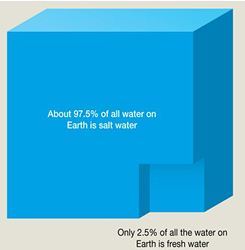7th Grade > Chemistry
WATER A PRECIOUS RESOURCE MCQs
:
Each step: 0.5 Mark
The following steps can be taken to conserve water:
1. Immediately repair any leaking tap in the household.
2. Close the tap while brushing teeth.
3. Used household water can be used for watering plants.
4. Avoid using a shower and use a bucketful of water instead.
:
Definition: 1 Mark
Answer: 1 Mark
The underground surface below which the ground is wholly saturated with water is the water table.
Yes, groundwater is fit for consumption as it is a source of freshwater.
:
Explanation: 3 Marks
Water seeps through spaces in the soil and gets collected in the cracks and spaces deep below the ground over porous rocks. This collected water forms a part of the groundwater and some droplets go further down and get collected over impervious rocks to form aquifers.
Water in the aquifers can be pumped out with the help of tube wells or handpumps.
:
Explanation: 3 Marks
Normal behavior for a liquid is to expand on heating and contract on cooling. A liquid that contracts is said to become denser.
Water behaves like a normal liquid when it's cooled down to 4 degrees(it contracts). But when cooled further down from 4 degrees to 0 degrees, it behaves anomalously i.e it expands instead of contracting further. So, ice at 0 degrees is less dense than water at 4 degrees.
When a lake starts getting cold, the water at the top hits 4 degrees becomes dense and sinks to the bottom, this keeps happening until all water in the lake has reached 4 deg Celsius. Now, when the temperature outside drops further, and the water at the top falls to 0 degree Celsius, the surface turns to ice. But ice at the top is less dense than the water at the bottom. So, it does not sink. This is why when you see a lake frozen at the top, the water below still remains at an even temperature of 4 degrees, where aquatic life can survive. This is how the anomalous expansion of water plays a major role in the sustenance of aquatic life in cold places.
:
Solution: 3 Marks
It's true that about 34th of the earth's surface is filled with water but not all of it can be used by us. The water in seas and oceans are saline water and cannot be used for day to day work. The fraction of usable water is very little and most of it is in the form of snow caps, glaciers. Only 0.006% water is available in the form of rivers, lakes, ponds, and groundwater.
Nowadays, even these sources are being contaminated due to industrial and agricultural activities. Also, due to increasing population and uneven rainfall, there is a shortage of usable water. So, we need to conserve water.
:
Sources: 1 Mark each
The various sources of groundwater are:
i) Rainwater
ii) Water from other sources such as rivers and ponds seeps through the soil and fills the empty spaces and cracks deep below the ground.
The process of seeping of water into the ground is called infiltration.
Which of the following statements is correct? [3 MARKS]
a) Collection of rainwater in overhead tanks helps in conservation of water.
b) Rainwater is responsible for replenishing of groundwater and collecting it would hamper the process. This practice would decrease water table levels and would make it difficult for us to access water.
:
Explanation : 3 Marks
It is true that rainfall is a major source of recharging groundwater but collecting rainwater is a good practice.
Generally, rainwater flows through the ground to the rivers, ponds, and lakes. In this process, rainwater seeps into the ground and recharges groundwater. But, in comparison to the amount of water we receive as rainfall, the amount of water we can collect is negligible.
Further, the water we use goes into the sewage which is ultimately treated and let out into rivers. From there it infiltrates the groundwater.
Moreover, the rainwater can be used for our day to day work and in order to access the same amount of water from the groundwater, we need to dig wells or boreholes to set up a pipe system. So, collecting rainwater is a good habit and the first statement is correct.
:
Explanation of water cycle: 3 Marks
Rivers, lakes, ponds and other sources get water from precipitation and melting of glaciers. The water from these sources along with precipitation replenishes the groundwater through infiltration. The groundwater runs off into the seas and the water on the surface reaches the seas through rivers.
From the sea, the water evaporates, reaches the atmosphere and forms clouds. Some ground water also reaches the atmosphere through evaporation and transpiration.
The clouds are responsible for precipitation or rains and thus the water again reaches the rivers, lakes, and ponds.
So, the water in these resources keeps flowing and never gets over.
:
Definition: 1 Mark each
Infiltration: The process of water seeping into the ground through the soil is called infiltration.
Infiltration refills the groundwater.
Aquifer: The spots where the groundwater is stored between layers of hard rocks below the water table are known as Aquifers.
It is a source of fresh water.
Drip Irrigation: Drip irrigation is the process of supplying water to plants by making use of narrow tubings which deliver water directly to the base of the plant.
Drip irrigation is a more efficient way than sprinkling water as it saves a lot of water.

















